Migration Patterns and Sedimentary Evolution of Deepwater Channels in the Niger Delta Basin
Abstract
1. Introduction
2. Geologic Setting
3. Data and Methods
4. Seismic Facies and Depositional Architectures
4.1. Submarine Channel
4.2. Lobes
4.3. Mass-Transport Deposits
4.4. Mud
5. Characteristics of Channel-Lobe Systems
5.1. Channel Systems
5.2. Channel Complex
5.2.1. Channel Complex in ECS
5.2.2. Channel Complex in WCS
5.3. Plane Migration Pattern
5.3.1. Expansion
5.3.2. Downstream Migration
- (1)
- Downstream migration in ECS
- (2)
- Downstream migration in WCS
6. Discussion
6.1. Differences and Combinations of Migration Patterns
6.1.1. Differences in Bend Segment Properties
6.1.2. Combinatorial Differences on a Plane
- (1)
- Expansion—Downstream migration combination
- (2)
- Downstream—Disorder—Downstream Migration Combination
6.2. Sedimentary Processes Under Sea-Level Fluctuation Constraints
6.3. Evolution of Channel Systems
7. Conclusions
- (1)
- The study area comprises a single submarine fan system developed through both channel and lobe components. Vertically, it consists of two distinct systems: the East Channel System(ECS) and the West Channel System (WCS). The lower portion of the ECS is dominated by a southward-extending lobate body, while the upper portion forms a curved channel belt. In contrast, the WCS exhibits a southwesterly lobate body in its lower section, with a more sharply curved channel belt in the upper section. In the proximal area, the two systems follow roughly parallel paths, but the WCS shifts westward in the middle section. Along the flow direction, the ECS channel belt displays a relatively gentle planar course before transitioning abruptly to a high-curvature segment. The WCS, in contrast, is more curved proximally, with its overall curvature decreasing following the mid-channel path shift.
- (2)
- Lateral migration of channels occurs through two primary mechanisms: Downstream and expansion migration. Downstream migration is typically associated with lower sinuosity values, whereas expansion-driven migration develops in segments with higher sinuosity. Even within a single area, migration types can coexist over relatively short distances of only a few kilometers. These two mechanisms often alternate or recur in plan view, forming two characteristic patterns: downstream–expansion and downstream–disorder–downstream. The downstream–expansion pattern is more prevalent in the lower portion of the stratigraphic sequence, while the downstream–disorder–downstream pattern dominates in the upper portion.
- (3)
- The study area in the Niger Delta developed within a complete 4th-order sea-level cycle, which encompassed four 5th-order cycles. The ECS formed during the first two 5-order cycles, whereas the WCS developed during the latter two, corresponding to the deposition of two deltaic lobes and two channel systems. In response to 5th-order sea-level falls, each sedimentary body exhibits coarser-grained gravelly sandy deposits at its base, transitioning upward to fine-grained siltstone and mudstone as sea level rose during the subsequent 5th-order transgressive phase.
- (4)
- Within this single submarine fan system, distinct channel systems display variations in planar morphology, sandstone content, migration patterns, and lithological characteristics. We interpret these differences as representing successive evolutionary stages of sediment gravity flows. In correspondence with four-stage sea-level fluctuations, the structural evolution of the submarine fan system in the study area can be divided into four phases: (1) An MTD and terminal fan dominated by debris flows and high-density turbidity currents; (2) ECS formed primarily by high-density turbidity currents, exhibiting sandy-dominated channel morphologies; (3) A terminal fan dominated by high-density turbidity currents with a predominantly sandy morphology; and (4) WCS dominated by both high- and low-density turbidity currents, featuring sand-silt-dominated deposits.
Author Contributions
Funding
Data Availability Statement
Conflicts of Interest
References
- Abreu, V.; Sullivan, M.; Pirmez, C.; Mohrig, D. Lateral accretion packages (LAPs): An important reservoir element in deep water sinuous channels. Mar. Pet. Geol. 2003, 20, 631–648. [Google Scholar] [CrossRef]
- De, L.F.C.; Smith, C.R.; Rowden, A.A.; Bowden, D.A.; Clark, M.R. Submarine canyons: Hotspots of benthic biomass and productivity in the deep sea. Proc. R. Soc. B Biol. Sci. 2010, 277, 2783–2792. [Google Scholar]
- Talling, P.J.; Paull, C.K.; Piper, D.J.W. How are subaqueous sediment density flows triggered, what is their internal structure and how does it evolve? Direct observations from monitoring of active flows. Earth-Sci Rev. 2013, 125, 244–287. [Google Scholar] [CrossRef]
- Paull, C.K.; Talling, P.J.; Maier, K.L.; Parsons, D.; Xu, J.; Caress, D.W.; Gwiazda, R.; Lundsten, E.M.; Anderson, K.; James, B.P.; et al. Powerful turbidity currents driven by dense basal layers. Nat. Commun. 2018, 9, 4114. [Google Scholar] [CrossRef] [PubMed]
- Zhao, X.; Qi, K.; Liu, L.; Xie, T.; Li, M.; Hu, G. Quantitative characterization and controlling factor analysis of the morphology of bukuma-minor channel on southern Niger Delta slope. Interpretation 2018, 6, 57–69. [Google Scholar] [CrossRef]
- OPEC World Oil Outlook 2017. Available online: https://www.opec.org/world-oil-outlook.html (accessed on 1 June 2025).
- Shanmugam, G. The hyperpycnite problem. J. Palaeogeogr. 2018, 7, 6. [Google Scholar] [CrossRef]
- Foreman, B.Z.; Lai, S.Y.J.; Komatsu, Y.; Paola, C. Braiding of submarine channels controlled by aspect ratio similar to rivers. Nat. Geosci. 2015, 8, 700–703. [Google Scholar] [CrossRef]
- Zhang, J.J.; Wu, S.H.; Fan, T.E.; Fan, H.J.; Jiang, L.; Chen, C.; Wu, Q.Y.; Lin, P. Research on the architecture of submarine-fan lobes in the Niger Delta Basin, offshore West Africa. J. Palaeogeogr. 2016, 5, 185–204. [Google Scholar] [CrossRef]
- Bouchakour, M.; Zhao, X.; Miclăuș, C.; Fei, L.; Gamboa, D.; Yang, B. Compartmentalization of submarine channel splays controlled by growth faults and mud diapir. Mar. Pet. Geol. 2025, 172, 107221. [Google Scholar] [CrossRef]
- Clark, I.R.; Cartwright, J.A. Key controls on submarine channel development in structurally active settings. Mar. Pet. Geol. 2011, 28, 1333–1349. [Google Scholar] [CrossRef]
- Howlett, D.M.; Gawthorpe, R.L.; Ge, Z.; Rotevatn, A.; Jackson, C.A.-L. Turbidites, topography and tectonics: Evolution of submarine channel-lobe systems in the salt-influenced Kwanza Basin, offshore Angola. Basin Res. 2021, 33, 1076–1110. [Google Scholar] [CrossRef]
- Gong, C.L.; Steel, R.J.; Wang, Y.M.; Lin, C.S.; Olariu, C. Grain size and transport regime at shelf edge as fundamental controls on delivery of shelf-edge sands to deepwater. Earth-Sci. Rev. 2016, 157, 32–60. [Google Scholar] [CrossRef]
- Morley, C.K.; Alvey, A. Is spreading prolonged, episodic or incipient in the Andaman Sea? Evidence from Deepwater sedimentation. J. Asian Earth Sci. 2015, 98, 446–456. [Google Scholar] [CrossRef]
- Deptuck, M.E.; Sylvester, Z.; Pirmez, C.; O’byrne, C. Migration-aggradation history and 3D seismic geomorphology of submarine channels in the pleistocene benin-major canyon, western niger delta slope. Mar. Pet. Geol. 2007, 24, 406–433. [Google Scholar] [CrossRef]
- Mutti, E.; Normark, W.R. An integrated approach to the study of turbidite systems. In Seismic Facies and Sedimentary Processes of Submarine Fans and Turbidite Systems; Weimer, P., Link, M.H., Eds.; Springer: New York, NY, USA, 1991; pp. 75–106. [Google Scholar]
- Tinterri, R.; Laporta, M.; Ogata, K. Asymmetrical cross-current turbidite facies tract in a structurally-confined Mini-Basin (Priabonian-Rupelian, Ranzano Sandstone, Northern Apennines, Italy). Sediment. Geol. 2017, 352, 63–87. [Google Scholar] [CrossRef]
- Pinter, P.R.; Butler, R.W.H.; Hartley, A.J.; Maniscalco, R.; Baldassini, N.; Di Stefano, A. Tracking sand-fairways through adeformed turbidite system: The numidian (Miocene) of CentralSicily, Italy. Basin Res. 2018, 30, 480–501. [Google Scholar] [CrossRef]
- Etienne, S.; Collot, J.; Sutherland, R.; Patriat, M.; Bache, F.; Rouillard, P.; Henrys, S.; Barker, D.; Juan, C. Deepwater sedimentation and cenozoic deformation in the southern New Caledonia trough (northern Zealandia, SW Pacific). Mar. Pet. Geol. 2018, 92, 764–779. [Google Scholar] [CrossRef]
- Turner, C.C.; Bastidas, R.E.; Connell, E.R.; Petrik, F.E. Proximal submarine fan reservoir architecture and development in the Upper urassic Brae Formation of the Brae fields, South Viking Graben, U.K. North Sea. In Rift-Related Coarse-Grained Submarine Fan Reservoirs; the Brae Play, South Viking Graben, North Sea; Turner, C.C., Cronin, B.T., Eds.; AAPG Memoir: Tulsa, OK, USA, 2018; Volume 115, pp. 213–256. [Google Scholar]
- Pizzi, M.; Whittaker, A.C.; Lonergan, L.; Mayall, M.; Mitchell, W.H. New statistical quantification of the impact of active deformation on the distribution of submarine channels. Geology 2021, 49, 926–930. [Google Scholar] [CrossRef]
- Gaitan, G.; Adam, J. Extent and variability of Mesozoic-Cenozoicmulti-stage salt diapirs in the Southern PermianBasin, Southern North Sea. Basin Res. 2023, 35, 2078–2117. [Google Scholar] [CrossRef]
- El-Azabi, M.H. Sedimentology and sequence stratigraphy of shallow and deeper marine Miocene deposits: Acase study from the St. Paul and Gebel El-Zeitblocks, Gulf of Suez, Egypt. Basin Res. 2024, 36, e12836. [Google Scholar] [CrossRef]
- Ramirez-Perez, P.; Cofrade, G.; Martín-Martín, J.D.; Travé, A. Stratigraphic evolution of a salt-walled basin: The influence of diapirism and compressional tectonics on the sedimentary record of the Estopanyà syncline (South-Central Pyrenees). Mar. Pet. Geol. 2024, 163, 106715. [Google Scholar] [CrossRef]
- Mayall, M.; Jones, E.; Casey, M. Turbidite channel reservoirs e key elements in facies prediction and effective development. Mar. Pet. Geol. 2006, 23, 821–841. [Google Scholar] [CrossRef]
- Janocko, M.; Nemec, W.; Henriksen, S.; Warchol, M. The diversity ofdeep-water sinuous channel belts and slope valley-fill complexes. Mar. Pet. Geol. 2013, 41, 7–34. [Google Scholar] [CrossRef]
- McHargue, T.; Pyrcz, M.J.; Sullivan, M.D.; Clark, J.D.; Fildani, A.; Romans, B.W.; Covault, J.A.; Levy, M.; Posamentier, H.W.; Drinkwater, N.J. Architecture of turbidite channel systems on the continental slope: Patterns and predictions. Mar. Pet. Geol. 2011, 28, 728–743. [Google Scholar] [CrossRef]
- Prather, B.E.; Deptuck, M.E.; Mohrig, D.; Mohrig, D.; Van, H.B.; Wynn, R.B. Application of the Principles of Seismic Geomorphology to Continental Slope and Base-of-Slope Systems: Case Studies from Seafloor and Near-Seafloor Analogues; SEPM: Tulsa, OK, USA, 2012; Volume 99, pp. 5–9. [Google Scholar]
- Hansen, L.; Janocko, M.; Kane, I.; Kneller, B. Submarine channel evolution, terrace development, and preservation of intra-channel thin-bedded turbidites: Mahin and Avon channels, offshore Nigeria. Mar. Geol. 2017, 383, 146–167. [Google Scholar] [CrossRef]
- Bouchakour, M.; Zhao, X.M.; Ge, J.W.; Miclauș, C.; Yang, B.Q. Evolution of submarine channel morphology in intra-slope mini-basins: 3D-seismic inter pretation from offshore Niger delta. Mar. Pet. Geol. 2022, 146, 105912. [Google Scholar] [CrossRef]
- Zhao, X.; Li, M.; Qi, K.; Liu, L.; Hu, G.; Wu, W.; Zhang, W.; Ge, J. Development of a Distinct Submarine Depositional System on a Topographically Complex Niger Delta Slope. Geol. J. 2020, 55, 3732–3747. [Google Scholar] [CrossRef]
- Zhao, X.; Qi, K.; Liu, L.; Gong, C.L.; McCaffrey, W.D. Development of a partially-avulsed submarine channel on the Niger Delta continental slope: Architecture and controlling factors. Mar. Pet. Geol. 2018, 95, 30–49. [Google Scholar] [CrossRef]
- Bouchakour, M.; Zhao, X.; Miclăuș, C.; Yang, B. Lateral migration and channel bend morphology around growing folds (Niger Delta continental slope). Basin Res. 2023, 35, 1154–1192. [Google Scholar] [CrossRef]
- Janocko, M.; Cartigny, M.B.J.; Nemec, W.; Hansen, E.W.M. Turbidity current hydraulics and sediment deposition in erodible sinuous channels: Laboratory experiments and numerical simulations. Mar. Pet. Geol. 2013, 41, 222–249. [Google Scholar] [CrossRef]
- Peakall, J.; Amos, K.J.; Keevil, G.M.; Bradbury, P.W.; Gupta, S. Flow processes and sedimentation in submarine channel bends. Mar. Pet. Geol. 2007, 24, 470–486. [Google Scholar] [CrossRef]
- Sylvester, Z.; Covault, J.A. Development of cutoff-related knickpoints during early evolution of submarine channels. Geology 2016, 44, 835–838. [Google Scholar] [CrossRef]
- Dorrell, R.M.; Peakall, J.; Burns, C.; Keevil, G.M. A novel mixing mechanism in sinuous seafloor channels: Implications for submarine channel evolution. Geomorphology 2018, 303, 1–12. [Google Scholar] [CrossRef]
- Doust, H.; Omatsola, E. Niger delta. In Divergent/Passive Margin Basins; Edwards, J.D., Santogrossi, P.A., Eds.; AAPG Bulletin: Tulsa, OK, USA, 1990; pp. 201–238. [Google Scholar]
- Zhao, X.; Qi, K.; Marco, P.; Tan, C.; Xie, T. Submarine channel network evolution above an extensive mass-transport complex: A 3D seismic case study from the Niger delta continental slope. Mar. Pet. Geol. 2019, 104, 231–248. [Google Scholar] [CrossRef]
- Damuth, J.E. Neogene gravity tectonics and depositional processes on the deep Niger Delta continental margin. Mar. Pet. Geol. 1994, 11, 320–346. [Google Scholar] [CrossRef]
- Spina, V.; Amoyedo, S.; Wibberley, C.; Tozer, R.; Ribes, C.; Maia, R.; Atoyebi, H.; Vincent, E. Characterization of a deep-water turbiditic reservoir under an active hydrodynamic regime (Niger delta). Mar. Pet. Geol. 2025, 172, 107185. [Google Scholar] [CrossRef]
- Hooper, R.J.; Fitzsimmons, R.J.; Grant, N.; Vendeville, B.C. The role of deformation in controlling depositional patterns in the south-central Niger Delta, West Africa. J. Struct. Geol. 2002, 24, 847–859. [Google Scholar] [CrossRef]
- Evamy, B.D.; Haremboure, J.; Kamerling, P.; Knaap, W.A.; Molloy, F.A.; Rowlands, P.H. Hydrocarbon habitat of Tertiary Niger Delta. AAPG Bull. 1978, 62, 1–39. [Google Scholar] [CrossRef]
- Morgan, R. Structural Controls on the Positioning of Submarine Channels on the Lower Slopes of the Niger Delta. Geol. Soc. Lond. Mem. 2004, 29, 45–52. [Google Scholar] [CrossRef]
- Briggs, S.E.; Davies, R.J.; Cartwright, J.A.; Morgan, R. Multiple detachment levels and their control on fold styles in the compressional domain of the deepwater west Niger Delta. Basin Res. 2006, 18, 435–450. [Google Scholar] [CrossRef]
- MacGregor, D.S.; Robinson, J.; Spear, G. Play fairways of the Gulf of Guinea transform margin. Geol. Soc. Spec. Publ. 2003, 207, 131–150. [Google Scholar] [CrossRef]
- Cobbold, P.R.; Clarke, B.J.; Løseth, H. Structural consequences of fluid overpressure and seepage forces in the outer thrust belt of the Niger Delta. Pet. Geosci. 2009, 15, 3–15. [Google Scholar] [CrossRef]
- Riboulot, V.; Cattaneo, A.; Berne, S.; Schneider, R.R.; Voisset, M.; Imbert, P.; Grimaud, S. Geometry and chronology of late Quaternary depositional sequences in the Eastern Niger Submarine Delta. Mar. Geol. 2012, 319–320, 1–20. [Google Scholar] [CrossRef]
- Hou, G.; Liu, H.; Zuo, Q. A study of distribution characteristics of petroleum in Niger delta basin and their controling factors. Oil Gas Geol. 2005, 26, 374–378. [Google Scholar]
- Westerhold, T.; Bickert, T.; Röhl, U. Middle to late Miocene oxygen isotope stratigraphy of ODP site 1085 (SE Atlantic): New constrain on Miocene climate variability and sea-level fluctuations. Palaeogeogr. Palaeoclimatol. Palaeoecol. 2005, 217, 205–222. [Google Scholar] [CrossRef]
- Haq, B.U.; Hardenbol, J.; Vail, P.R. Chronology of fluctuating sea levels since the Triassic. Science 1987, 235, 1156–1166. [Google Scholar] [CrossRef]
- Zhang, J.J.; Wu, S.H.; Hu, G.Y.; Fan, T.E.; Yu, B.; Lin, P.; Jiang, S.N. Sea-level control on the submarine fan architecture in a deepwater sequence of the Niger Delta Basin. Mar. Pet. Geol. 2018, 94, 179–197. [Google Scholar] [CrossRef]
- Othman, A.A.A.; Fathy, M.; Maher, A. Use of spectral decomposition technique for delineation of channels at solar gas discovery, offshore West Nile Delta, Egypt. Egypt. J. Pet. 2016, 25, 45–51. [Google Scholar] [CrossRef]
- Maestrelli, D.; Iacopini, D.; Jihad, A.A.; Bond, C.E.; Bonini, M. Seismic and structural characterization of fluid escape pipes using 3d and partial stack seismic from the loyal field (Scotland, UK): A multiphase and repeated intrusive mechanism. Mar. Pet. Geol. 2017, 88, 489–510. [Google Scholar] [CrossRef]
- Rodriguez, C.R.; Jackson, C.A.-L.; Bell, R.E.; Rotevatn, A.; Francis, M. Deep-water reservoir distribution on a salt-influenced slope, Santos Basin, offshore Brazil. AAPG Bulletin. 2021, 105, 1679–1720. [Google Scholar] [CrossRef]
- Chen, M.; Wu, S.; Wang, R.; Zhang, J.; Xie, P.; Wang, M.; Wang, X.; Xiong, Q.; Yu, J.; Miramontes, E. Sedimentary architecture of submarine lobes affected by bottom currents: Insights from the Rovuma Basin offshore East Africa. Basin Res. 2024, 36, e12829. [Google Scholar] [CrossRef]
- Yao, X.; Feng, C.; Qu, H.; Zhang, M.; Li, D. The Middle Miocene lobe-shaped and band-shaped submarine fans in the Lingshui Sag, Qiongdongnan Basin: Source-to-sink system, genesis and implication. Acta Oceanol. Sin. 2024, 43, 61–79. [Google Scholar] [CrossRef]
- Moscardelli, L.; Wood, L. New classification system for mass transport complexes in offshore Trinidad. Basin Res. 2008, 20, 73–98. [Google Scholar] [CrossRef]
- Boulesteix, K.; Poyatos-Moré, M.; Flint, S.S.; Taylor, K.G.; Hodgson, D.M.; Hasiotis, S.T. Transport and deposition of mud in deep-water environments: Processes and stratigraphic implications. Sedimentology 2019, 66, 2894–2925. [Google Scholar] [CrossRef]
- Straub, K.M.; Mohrig, D. Constructional canyons built by sheet-like turbidity currents: Observations from offshore Brunei Darussalam. J. Sediment. Res. 2009, 79, 24–39. [Google Scholar] [CrossRef]
- Mutti, E.; Normark, W.R. Comparing examples of modern and ancient turbidite systems: Problems and concepts. In Marine Clastic Sedimentology: Concepts and Case Studies; Springer: Dordrecht, The Netherlands, 1987; pp. 1–38. [Google Scholar]
- Prather, B.E.; Booth, J.R.; Steffens, G.S.; Craig, P.A. Classification, lithologic calibration, and stratigraphic succession of seismic facies of intraslope basins, deep-water Gulf of Mexico. AAPG Bull. 1998, 82, 701–728. [Google Scholar] [CrossRef]
- Pickering, K.T.; Cantalejo, B. Deep-marine environments of the Middle Eocene Upper Hecho Group, Spanish Pyrenees: Introduction. Earth-Sci. Rev. 2015, 144, 1–9. [Google Scholar] [CrossRef]
- Cullis, S.; Colombera, L.; Patacci, M.; McCaffrey, W.D. Hierarchical classifications of the sedimentary architecture of deep-marine depositional systems. Earth-Sci. Rev. 2018, 179, 38–71. [Google Scholar] [CrossRef]
- Li, S.L.; Gong, C.L. Flow dynamics and sedimentation of lateral accretion packages in sinuous deep-water channels: A 3D seismic case study from the northwestern South China Sea margin. J. Asian Earth Sci. 2016, 124, 233–246. [Google Scholar] [CrossRef]
- Deptuck, M.E.; Steffens, G.S.; Barton, M.; Pirmez, C. Architecture and evolution of upper fan channel-belts on the Niger Delta slope and in the Arabian Sea. Mar. Pet. Geol. 2003, 20, 649–676. [Google Scholar] [CrossRef]
- Sylvester, Z.; Pirmez, C.; Cantelli, A. A model of submarine channel-levee evolution based on channel trajectories: Implications for stratigraphic architecture. Mar. Pet. Geol. 2011, 28, 716–727. [Google Scholar] [CrossRef]
- Posamentier, H.W.; Kolla, V.; Liu, H.Q. An Overview of Deepwater Turbidite Deposition. Acta Sedimentol. Sin. 2019, 37, 879–903. [Google Scholar]
- Alan, D.H.; Thomas, R.K. Sufficient Conditions for River Meandering: A Simulation Approach. Water Resour. Res. 1984, 20, 1659–1667. [Google Scholar] [CrossRef]
- Shi, S.Y.; Ding, W.L.; Yu, Y.X.; Zhang, J.X. Deformation and Evolution of Akata Formation Mudstone in the Niger Delta Basin: Insights from Analogue Models. J. Mar. Sci. Eng. 2025, 13, 590. [Google Scholar] [CrossRef]
- Zhang, J.J.; Wu, S.H.; Hu, G.Y.; Yue, D.L.; Chen, C.; Chen, M.; Yu, J.T.; Xiong, Q.C.; Wang, L.Q. Sedimentary-tectonic interaction on the growth sequence architecture within the intraslope basins of deep-water Niger Delta Basin. J. Palaeogeogr. 2023, 12, 107–128. [Google Scholar] [CrossRef]
- Olayiwola, M.A.; Bamford, M.K.; Durugbo, E.U. Graphic correlation: A powerful tool for biostratigraphic correlation of petroleum exploration and production in the Cenozoic deep offshore Niger Delta, Nigeria. J. Afr. Earth Sci. 2017, 131, 156–165. [Google Scholar] [CrossRef]
- Fadiya, L.S.; Salami, B.M. A Neogene calcareous nannofossil biozonation scheme for the deep offshore Niger Delta. J. Afr. Earth Sci. 2015, 112, 251–275. [Google Scholar] [CrossRef]
- Corredor, F.; Shaw, J.H.; Bilotti, F. Structural styles in the deep-water fold and thrust belts of the Niger Delta. AAPG Bull. 2005, 89, 753–780. [Google Scholar] [CrossRef]
- Bonne, K.P.M. Reconstruction of the evolution of the Niger River and implications for sediment supply to the Equatorial Atlantic margin of Africa during the Cretaceous and the Cenozoic. In Sediment Provenance Studies in Hydrocarbon Exploration and Production; Geological Society of London: London, UK, 2014; Volume 386, pp. 327–349. [Google Scholar]
- Shanmugam, G. High-density turbidity currents: Are they sandy debris flows? J. Sediment. Res. 1996, 66, 2–10. [Google Scholar] [CrossRef]
- Shanmugam, G. The Bouma sequence and the turbidite mind set. Earth-Sci. Rev. 1997, 42, 201–229. [Google Scholar] [CrossRef]
- Lowe, D.R. Sediment gravity flows; II, Depositional models with special reference to the deposits of high-density turbidity currents. J. Sediment. Res. 1982, 52, 343–361. [Google Scholar] [CrossRef]
- Keevil, G.M.; Peakall, J.; Best, J.L.; Amos, K.J. Flow structure in sinuous submarine channels: Velocity and turbulence structure of an experimental submarine channel. Mar. Geol. 2006, 229, 241–257. [Google Scholar] [CrossRef]
- Stevenson, C.J.; Jackson, C.A.-L.; Hodgson, D.M.; Hubbard, S.M.; Eggenhuisen, J.T. Deep-water sediment bypass. J. Sediment. Res. 2015, 85, 1058–1081. [Google Scholar] [CrossRef]
- Catuneanu, O.; Abreu, V.; Bhattacharya, J.P.; Blum, M.D.; Dalrymple, R.W.; Eriksson, P.G.; Fielding, C.R.; Fisher, W.L.; Galloway, W.E.; Gibling, M.R.; et al. Towards the standardization of sequence stratigraphy. Earth-Sci. Rev. 2009, 92, 1–33. [Google Scholar] [CrossRef]



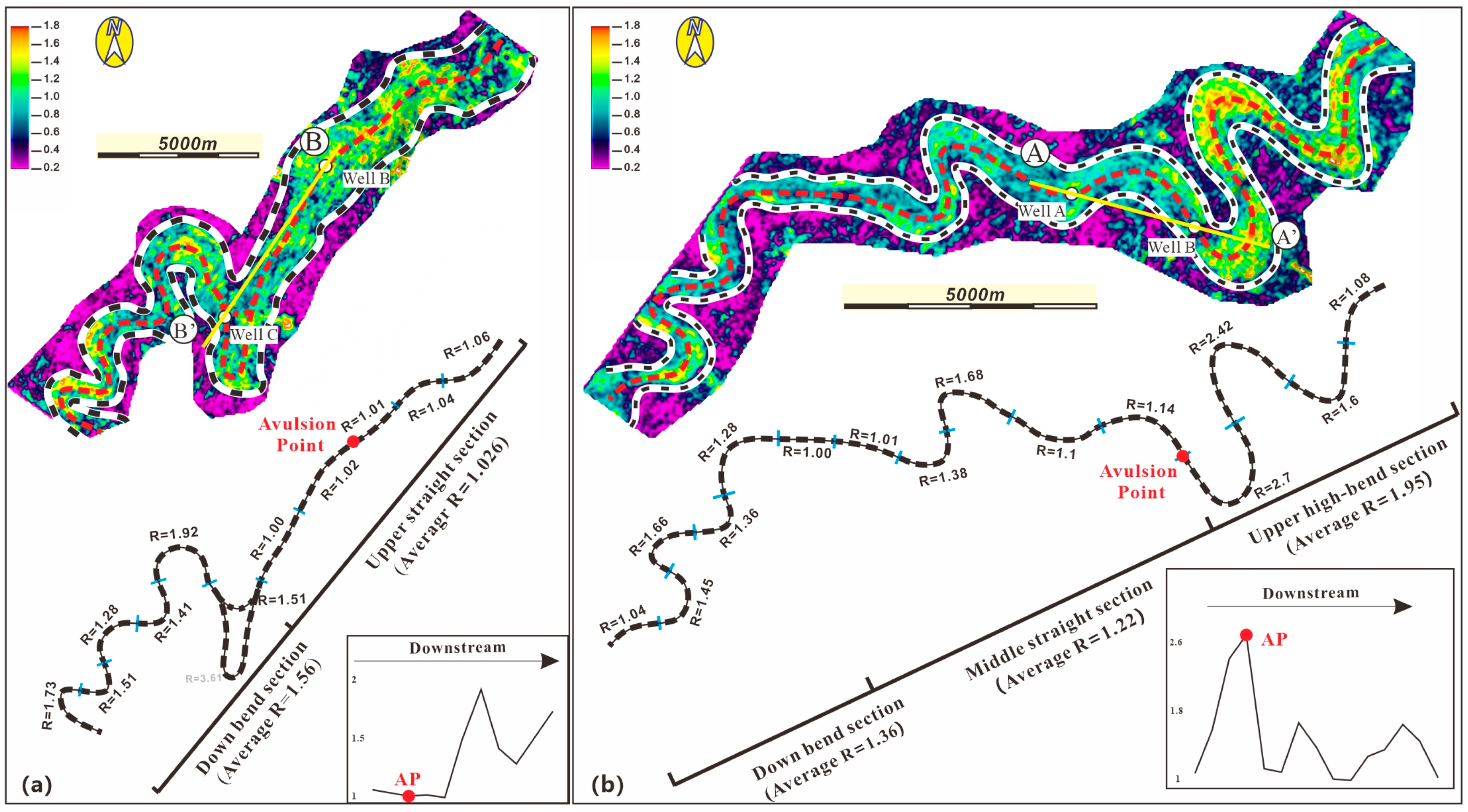
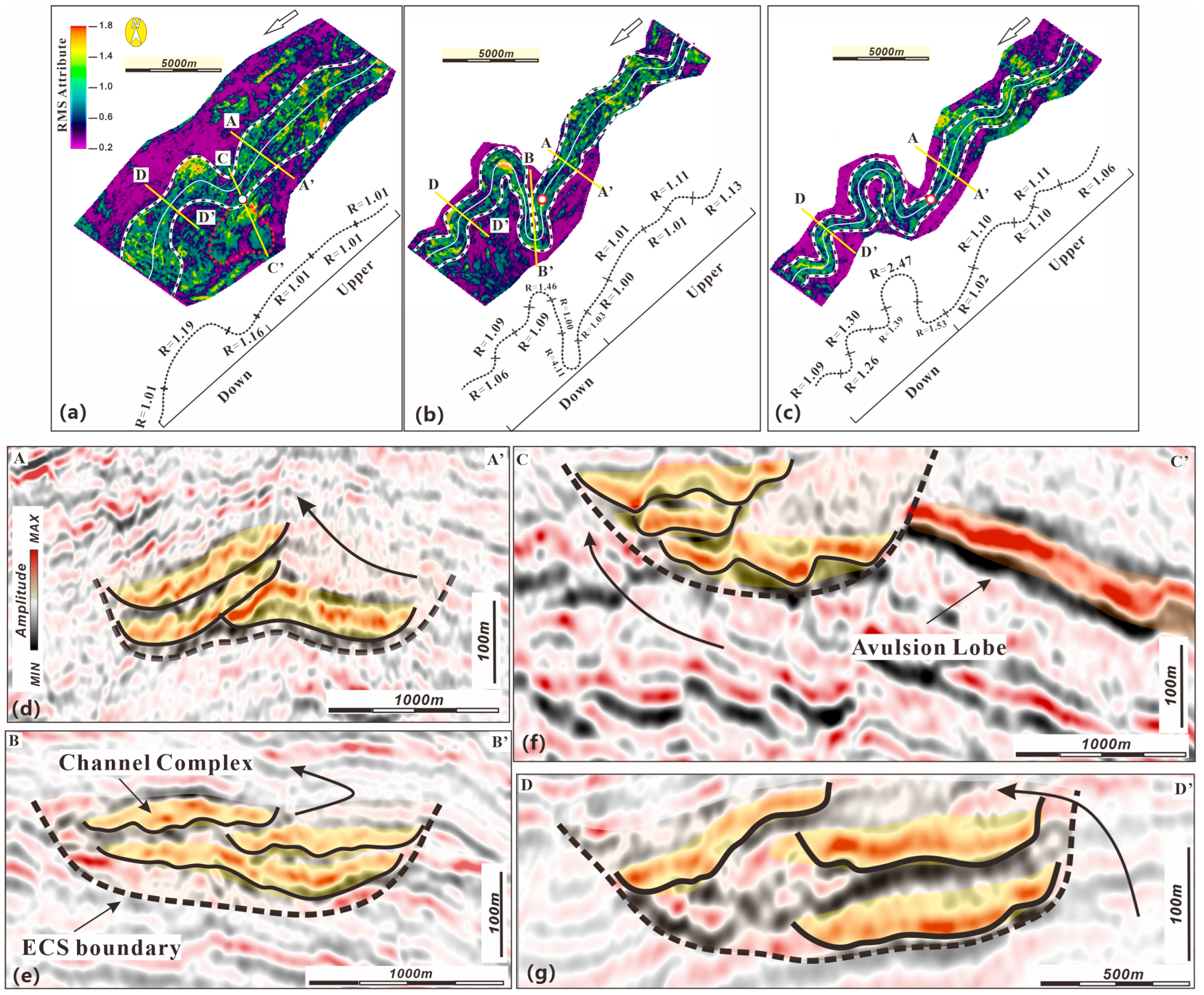
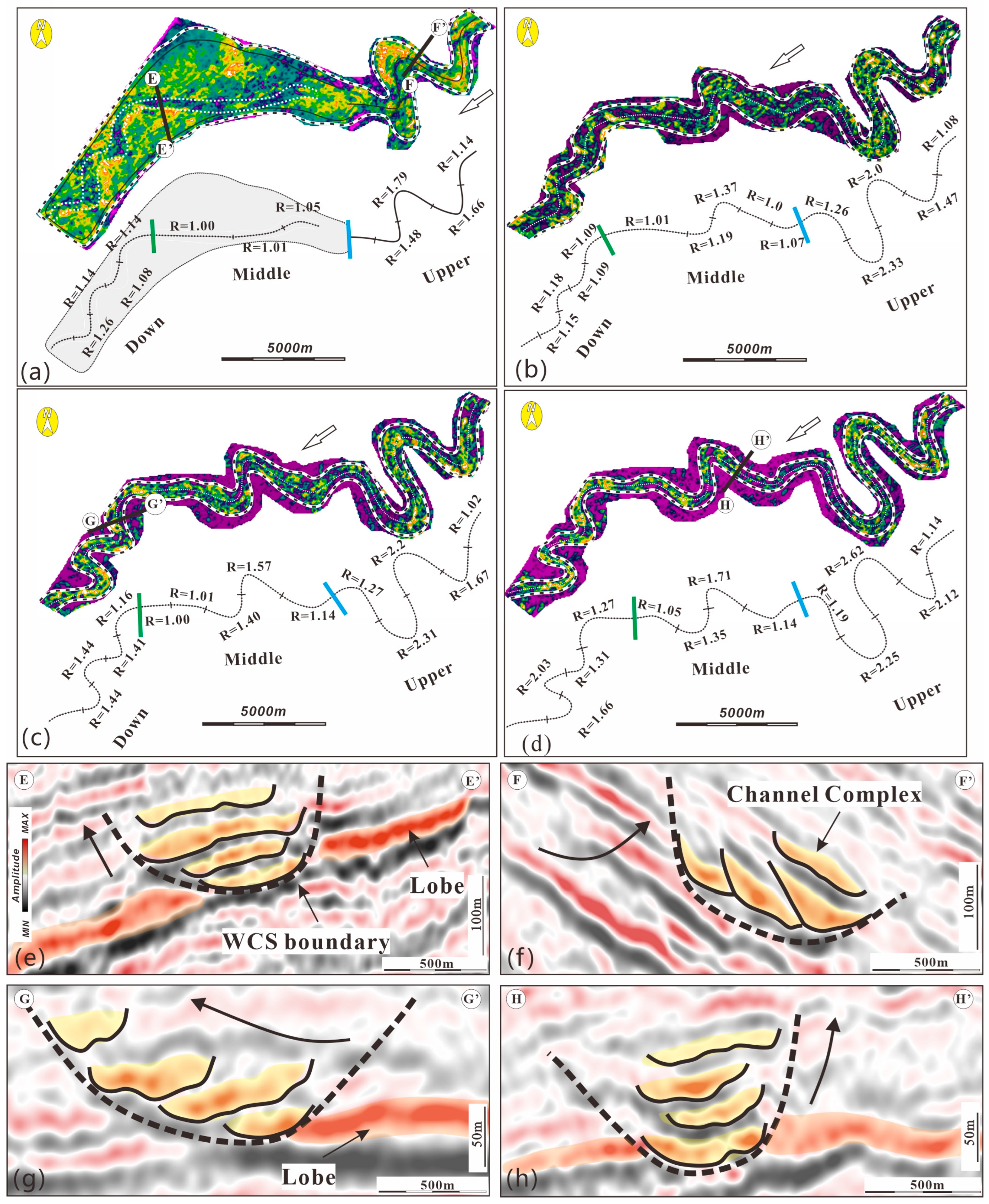
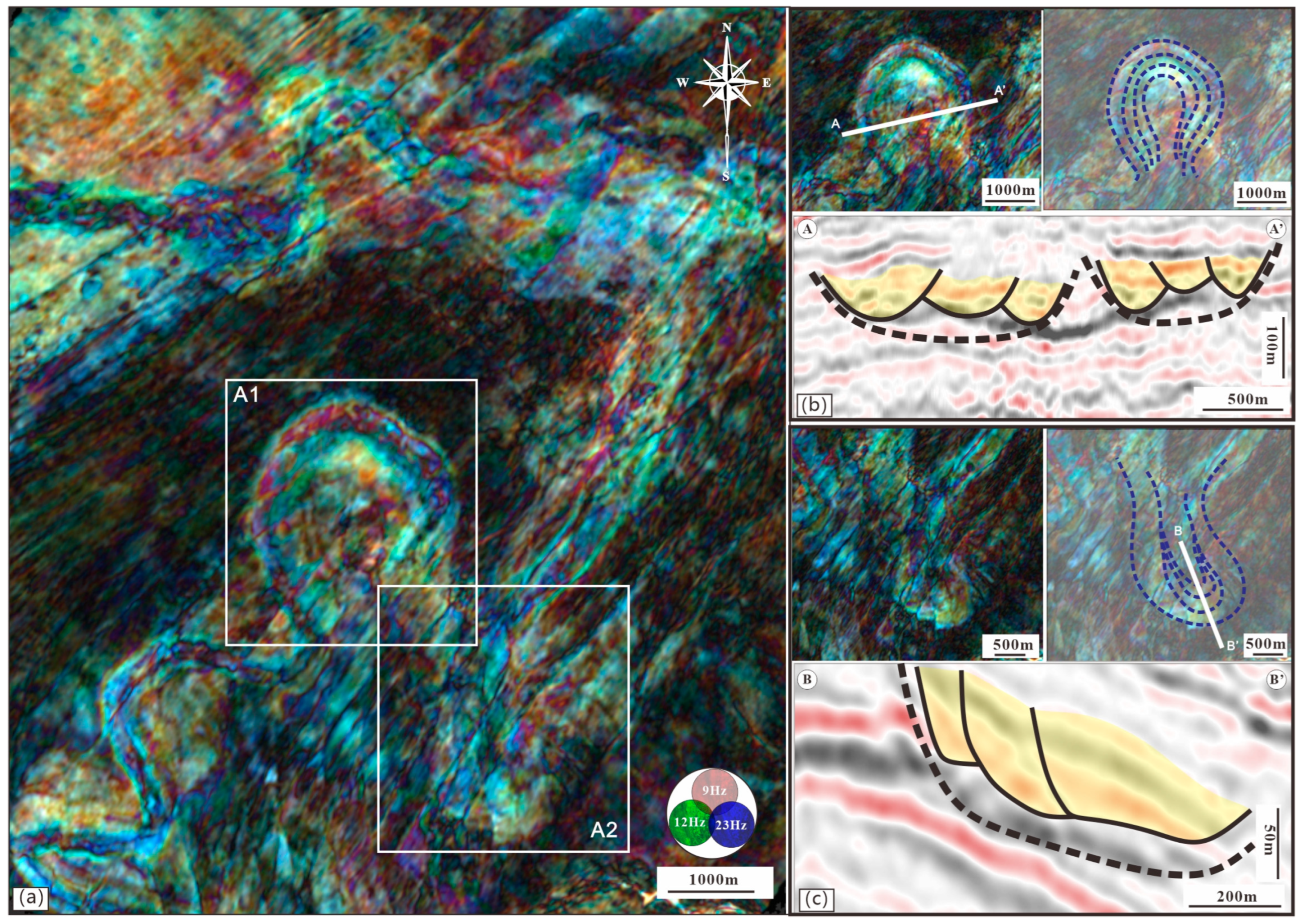
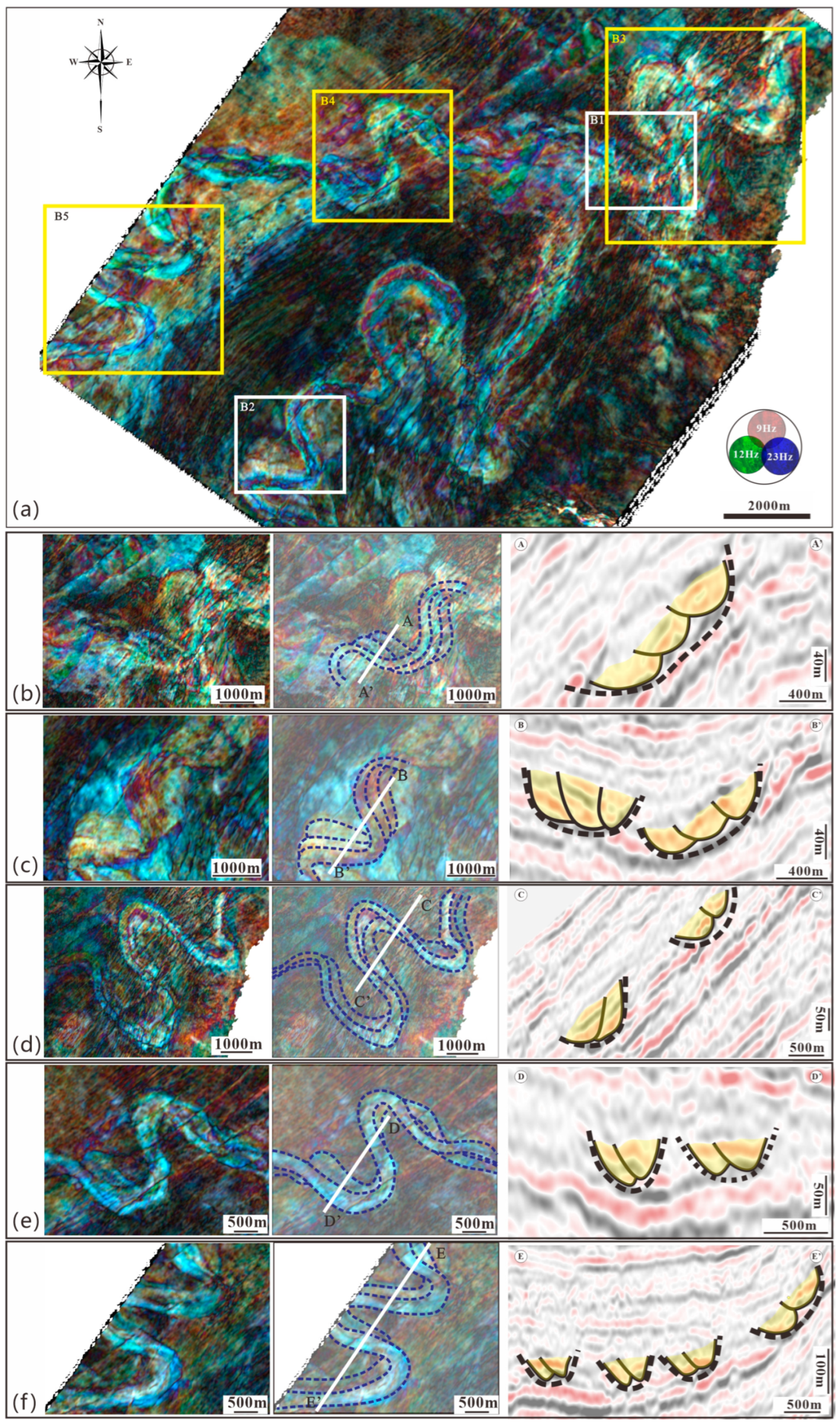

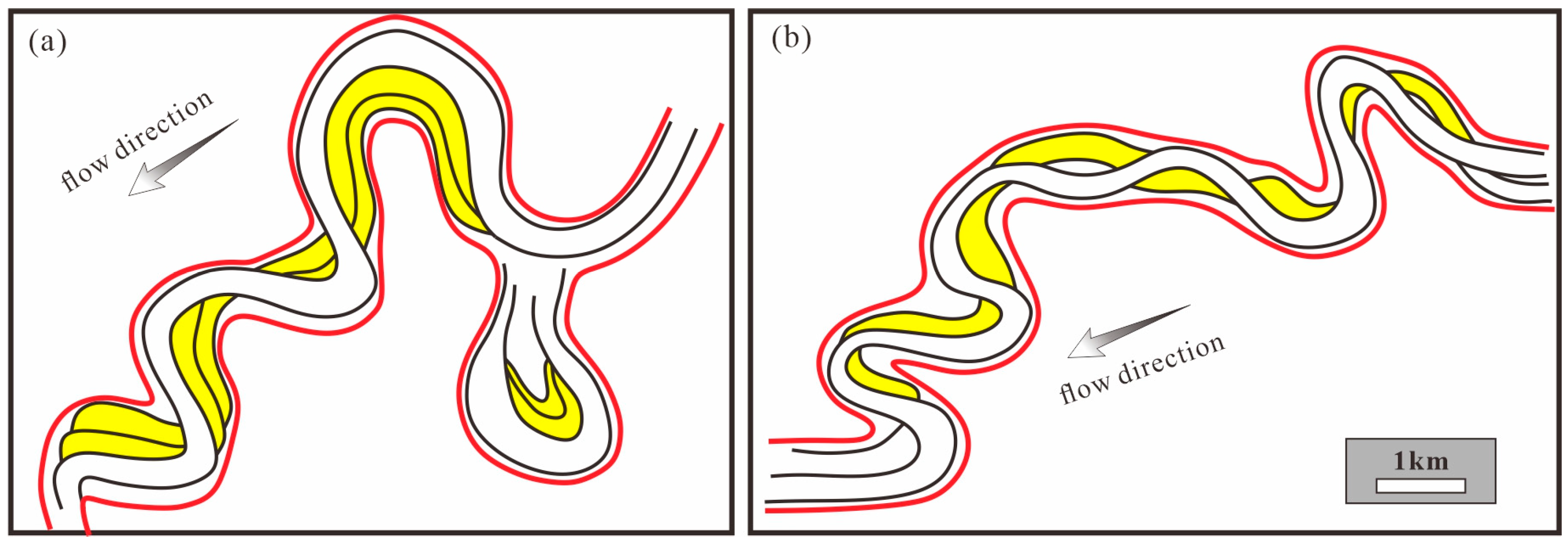
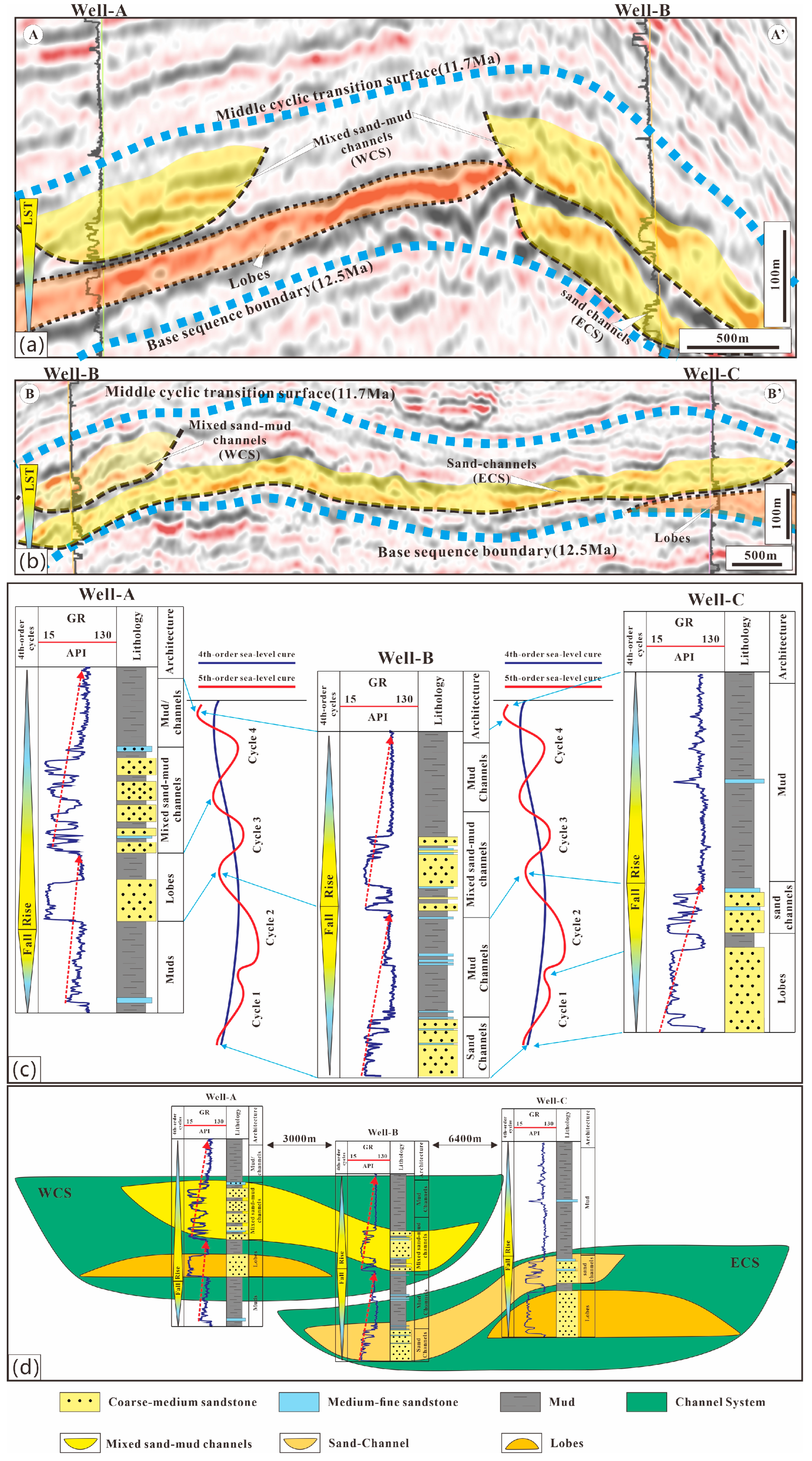
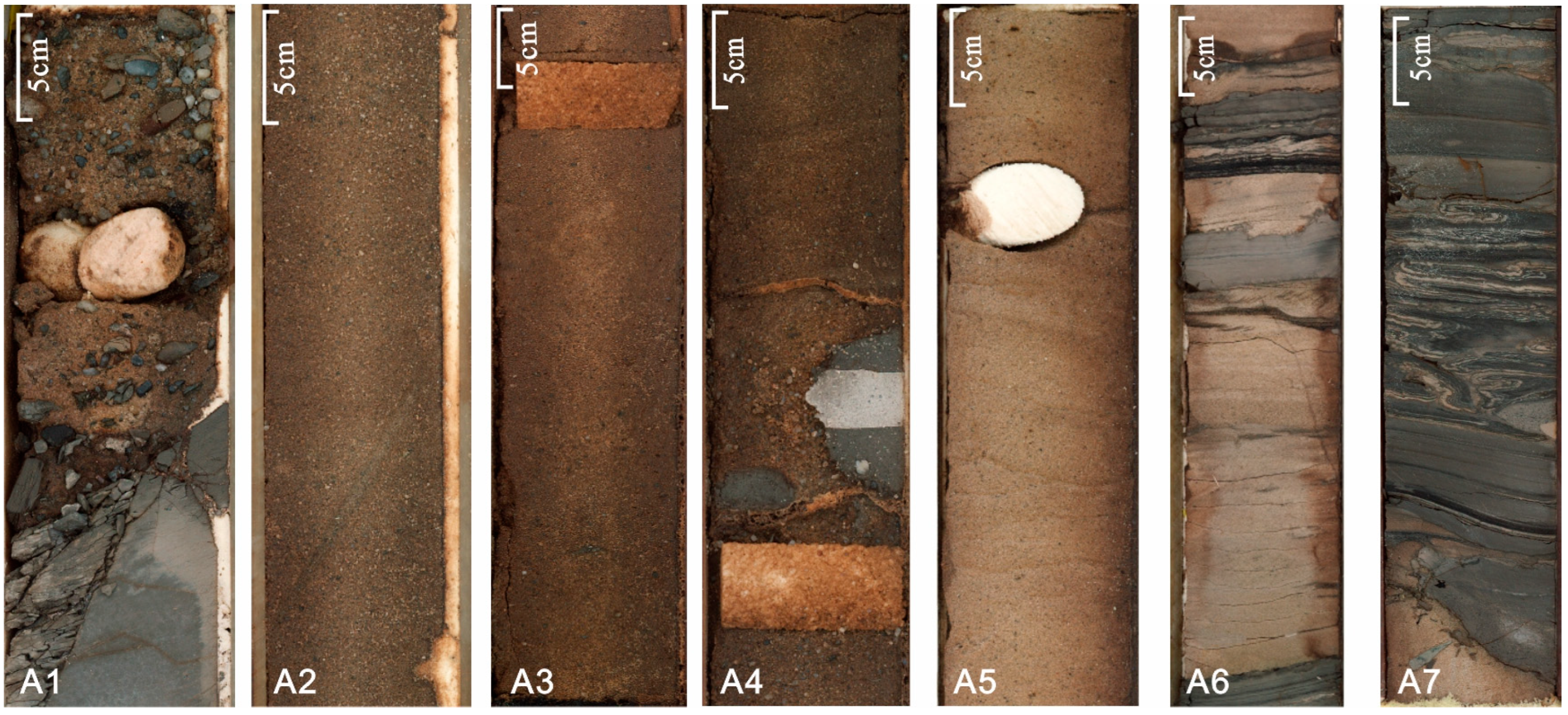

| Seismic Facies | Amplitude and Geometry Reflections | Seismic Section | RMS Attribute Map |
|---|---|---|---|
| Submarine Channel | U-shaped incised fills exhibit basal erosion surfaces truncating underlying strata, with internally discontinuous, high-amplitude subparallel reflections, indicative of cut-and-fill deposition during channel evolution |  | 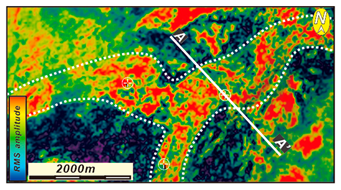 |
| Lobes | Wedge-shaped deposits overlie the substrate with continuous, high-amplitude subparallel reflections, extending over broad lateral areas, suggesting sustained sediment delivery during lobe development |  | 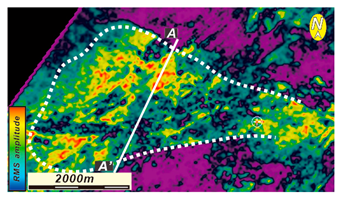 |
| Mass-transport deposits | Elongated or wedge-shaped deposits exhibit internally continuous but chaotic low-amplitude reflections, with evident erosion of underlying strata, suggesting rapid deposition following erosional events. | 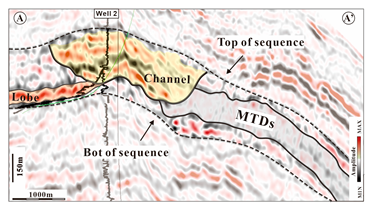 | 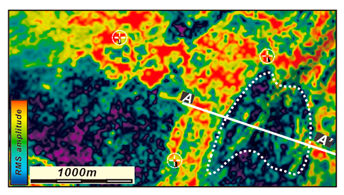 |
| Mud | Horizontally stratified, with a small thickness range, in parallel contact with the upper and lower strata | 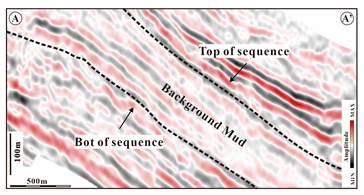 | 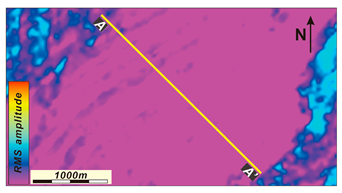 |
Disclaimer/Publisher’s Note: The statements, opinions and data contained in all publications are solely those of the individual author(s) and contributor(s) and not of MDPI and/or the editor(s). MDPI and/or the editor(s) disclaim responsibility for any injury to people or property resulting from any ideas, methods, instructions or products referred to in the content. |
© 2025 by the authors. Licensee MDPI, Basel, Switzerland. This article is an open access article distributed under the terms and conditions of the Creative Commons Attribution (CC BY) license (https://creativecommons.org/licenses/by/4.0/).
Share and Cite
Liu, F.; Zhao, X.; Ge, J.; Qi, K.; Bouchakour, M.; Cao, S. Migration Patterns and Sedimentary Evolution of Deepwater Channels in the Niger Delta Basin. J. Mar. Sci. Eng. 2025, 13, 2135. https://doi.org/10.3390/jmse13112135
Liu F, Zhao X, Ge J, Qi K, Bouchakour M, Cao S. Migration Patterns and Sedimentary Evolution of Deepwater Channels in the Niger Delta Basin. Journal of Marine Science and Engineering. 2025; 13(11):2135. https://doi.org/10.3390/jmse13112135
Chicago/Turabian StyleLiu, Fei, Xiaoming Zhao, Jiawang Ge, Kun Qi, Massine Bouchakour, and Shuchun Cao. 2025. "Migration Patterns and Sedimentary Evolution of Deepwater Channels in the Niger Delta Basin" Journal of Marine Science and Engineering 13, no. 11: 2135. https://doi.org/10.3390/jmse13112135
APA StyleLiu, F., Zhao, X., Ge, J., Qi, K., Bouchakour, M., & Cao, S. (2025). Migration Patterns and Sedimentary Evolution of Deepwater Channels in the Niger Delta Basin. Journal of Marine Science and Engineering, 13(11), 2135. https://doi.org/10.3390/jmse13112135






